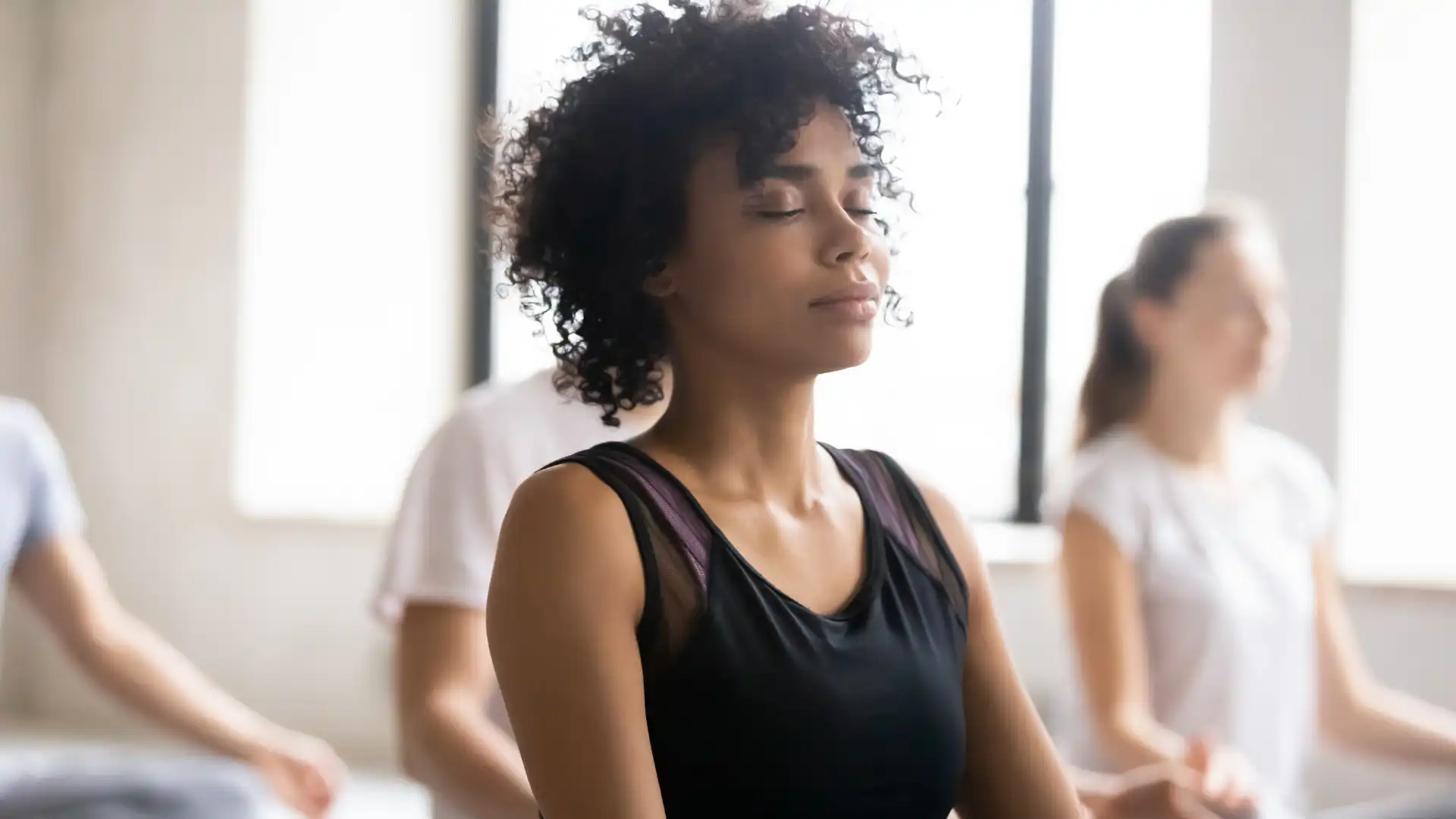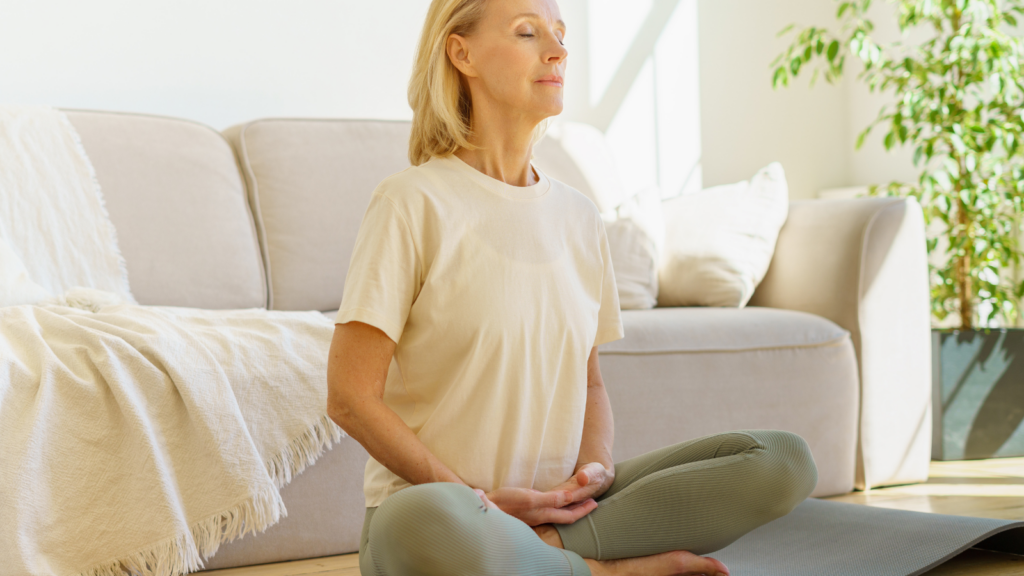Yoga for Neck Health: Exploring Brahma Mudra

Article At A Glance
Learn about Brahma Mudra, a breathing technique that merges movement and sound. Dr. Baxter Bell explains how this practice can restore fluidity and vitality to the neck, a vital junction between the brain and the body.
The neck is a vital area for your overall health. It is the conduit between your head and body through which your spinal cord and several large blood vessels, as well as your large breathing tube and esophagus—your feeding tube—pass. And it is also home to your thyroid gland, which helps to regulate your metabolism.
I recently learned about a mudra, Brahma Mudra (the Divine Spiritual Gesture), from one of my fellow panelists at a SYTAR Conference, Dr. Ananda Bhavanani, MD, from Pondicherry, India, who is both a Western-trained physician and a yoga therapist.
Unlike hand mudras the Brahma Mudra involves movement and sound (Note: There is also a hand gesture by the same name, but that is not the subject of this post). Dr. Bhavanani said this mudra can help you on a physical level with pain and stiffness in the head, neck, shoulders, and upper back and help to optimize the overall functions of the neck region.
Brahma Mudra Benefits
According to Dr. Bhavanani, this mudra helps cultivate psychosomatic harmony (body-mind balance), which can be useful for managing stress and mood swings, cultivating relaxation, and instilling a sense of mental lightness. According to Dr. Bhavanani, it can also enhance and balance our perspectives on life. (That’s a lot of uses and potential benefits! It is important to keep in mind, however, that these claims come from the yoga tradition, and results have only been reported anecdotally. As far as I know, the effects of this mudra have not been studied systematically or scientifically.)
So how, you may be asking, do you do Brahma Mudra? Just as the Hindu deity Brahma, the creator, has four heads that point in the cardinal directions of a compass, in this dynamic practice, you move your one head in four directions with your breath, using the Bija seed sounds “ah,” “uuu,” “eee” and “mmm”on your four exhalations.
I was immediately interested in Brahma Mudra’s potential benefits for my own neck, having been involved in a car accident years ago that has left me with some chronic stiffness and changes in my range of motion, compounded by my lifelong violin playing, which tips and turns my head to the left.
Since the conference last mid-June, I have been doing this practice for 9-12 rounds almost every morning. So far, it has been very effective in reducing my stiffness and seems to be slowly improving the range of motion of my neck. Due to the mental focus on movement and on making the Bija sounds, it has both a meditative and pranayama effect of calming, quieting, and centering my mind. Excited by the accessibility and benefits of the practice, I have been teaching the practice to my students and yoga therapy clients in recent weeks.
It is worth mentioning, however, that as with many yoga practices, there is more than one way to do this mudra. In fact, my colleague Dilip Sarkar, MD, has a slightly different version in his new book, Yoga Therapy, Ayurveda, and Western Medicine (pages 103-106). Dilip told me that doing this practice daily for some years now has helped him overcome the symptoms of his cervical radiculopathy, a technical term for neck pain due to degenerative changes in the bone and soft tissue structures of the spine.
The following instructions are based on the technique I learned from Dr. Bhavanani.
How to Practice Brahma Mudra

1. Take a comfortable seat, either on the floor or on a chair. Sit with good posture and your face forward, and close your eyes.
2. Inhale slowly (over 4-6 seconds) as you slowly turn your head to the right.
3. Exhale slowly (over 4-6 seconds) and make the sound “ah” as you slowly turn your head to center.
4. On your next slow inhalation, slowly turn your head to the left.
5. On your slow exhalation, make the sound “uuu” as you slowly turn your head to the center.
6. On your next slow inhalation, slowly tip your head back, keeping the back of your neck long.
7. On your slow exhalation, make the sound “eee” as you slowly tip your head back to the center.
8. On your next slow inhalation, slowly tip your head down, bringing your chin toward your chest.
9. On your slow exhalation, make the sound “mmm” as you slowly bring your head back to the center.
Repeat the Brahma Mudra for 3-12 rounds.
Also, read...
Understanding Your Sciatic Nerve Pain and How Yoga Might Help
Dec 12 – By: Meagan McCrary, E-RYT 500
Got Foot Pain? Try These Yoga Practices
Jul 15 – By: Baxter Bell, MD
Wrist Pain During Yoga? 4 Tricks to Eliminate Discomfort
May 07 – By: Meagan McCrary
Related courses
Reprinted with permission from Yoga for Healthy Aging Blog.

Baxter Bell, MD, C-IAYT, YACEP, fell in love with yoga in 1993 while he was working full-time as a family physician. His appreciation for the potential of yoga to foster health, healing, and equanimity was so great that he soon stepped down from his medical practice and trained to become a yoga teacher. Now, he focuses on teaching yoga full time, both to ordinary students of all ages and physical conditions and to the next generation of yoga teachers and yoga therapists, to whom he teaches anatomy and yoga therapy along with his accessible, skillful style of yoga. He also sees students privately, helping them use yoga to help heal from and/or cope with a wide range of medical conditions. At this point, with 23+ years of teaching experience under his belt, Baxter brings a unique perspective to his teaching, combining his understanding of anatomy and medicine with his skill at instructing people from all walks of life and all levels of ability.
In addition to teaching classes, workshops, and retreats internationally, Baxter is a past presenter at Yoga Journal Conferences and the International Association of Yoga Therapy’s Sytar Conference and teaches online courses and classes at Yoga U Online. Baxter is also the co-author of the popular and ground-breaking book Yoga for Healthy Aging and his blog, “What’s On Your (Yoga) Mind,” where he shares his knowledge of medical conditions, anatomy, yoga, and more with practitioners and teachers across the world. He has written articles for the Yoga Journal and the Journal of the International Association of Yoga Therapy. He is often quoted as an expert on yoga and health by major national news outlets such as the Washington Post and the Wall Street Journal. To learn more, visit www.baxterbell.com, and his YouTube channel and Instagram page at Baxter Bell Yoga.
Recent articles
Asana Is a Question – Shifting from Performance to Presence in Yoga (Free Video with Judith Hanson Lasater)
Dec 18 – Eva Norlyk Smith, Ph.D.
Free Yoga Video! A Gratitude Practice with Judith Hanson Lasater
Dec 16 – Eva Norlyk Smith, Ph.D.
Teaching Svadhyaya: 3 Ways to Encourage Self-Study in Yoga
Dec 15 – Meagan McCrary
Categories
Upcoming courses
Recent articles
Almost there...
Sorry, we couldn't find anything...
Yoga Teaching
Asana Is a Question – Shifting from Performance to Presence in Yoga (Free Video with Judith Hanson Lasater)
Discovering the True Purpose of Your Yoga Practice Here’s a question for you: When…
Dec 18 – Eva Norlyk Smith, Ph.D.
Yoga Teaching
Free Yoga Video! A Gratitude Practice with Judith Hanson Lasater
How Your Practice Can Cultivate a Richer Emotional Life We usually think of yoga…
Dec 16 – Eva Norlyk Smith, Ph.D.
Yoga Practice Tips
Teaching Svadhyaya: 3 Ways to Encourage Self-Study in Yoga
As yoga teachers, our job is to teach yoga. This means more than…
Dec 15 – Meagan McCrary



